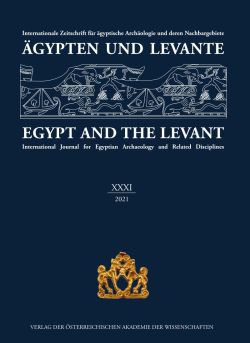Egypt and the Levant was founded by Manfred Bietak in 1990 to provide a publication platform for the research on cultural contacts between Egypt and her neighbours. A focus of interest was the Egyptian-Canaanite fusion of cultures, which was mainly encountered at the site of Tell el-Dab’a during the Austrian excavations. From the beginning, the scope of the journal was international and interdisciplinary. The subject area has now been greatly expanded far beyond the original topics. It comprises reports and preliminary reports on archaeological excavations in Egypt and the entire Middle East including the Sudan, as well as articles dealing with all aspects of Egyptian and Near Eastern archaeology, history or cultural history. The main emphasis lays on the pharaonic period, but both contributions to prehistory of the said regions, and post-pharaonic periods may be accepted. In addition, a broad range of scientific topics is covered, including C14-dating, material analyses, archaeobotanical and archaeozoological studies as well as studies in physical anthropology.
Egypt and the Levant is published on an annual basis, both in print and online. Submitted articles are intended to be published in a timely manner. Manuscripts may be submitted in English, German or French. Book reviews are not accepted. All submitted articles are subject to international peer-review according to quality standards of the Austrian Academy of Sciences.
|
Ägypten und Levante XXXI
Egypt and the Levant XXXI
ISSN 1015-5104
Print Edition
ISSN 1813-5145
Online Edition
ISBN 978-3-7001-9161-2
Print Edition
ISBN 978-3-7001-9162-9
Online Edition

|
Send or fax to your local bookseller or to:
Verlag der Österreichischen Akademie der Wissenschaften
Austrian Academy of Sciences Press
A-1011 Wien, Dr. Ignaz Seipel-Platz 2,
Tel. +43-1-515 81/DW 3420, Fax +43-1-515 81/DW 3400
https://verlag.oeaw.ac.at, e-mail: bestellung.verlag@oeaw.ac.at
UID-Nr.: ATU 16251605, FN 71839x Handelsgericht Wien, DVR: 0096385
Bitte senden Sie mir
Please send me |
|
Exemplar(e) der genannten Publikation
copy(ies) of the publication overleaf |
NAME
|
ADRESSE / ADDRESS
|
ORT / CITY
|
LAND / COUNTRY
ZAHLUNGSMETHODE / METHOD OF PAYMENT
Visa Euro / Master American Express
|
NUMMER
|
Ablaufdatum / Expiry date:
I will send a cheque
Vorausrechnung / Send me a proforma invoice
|
|
